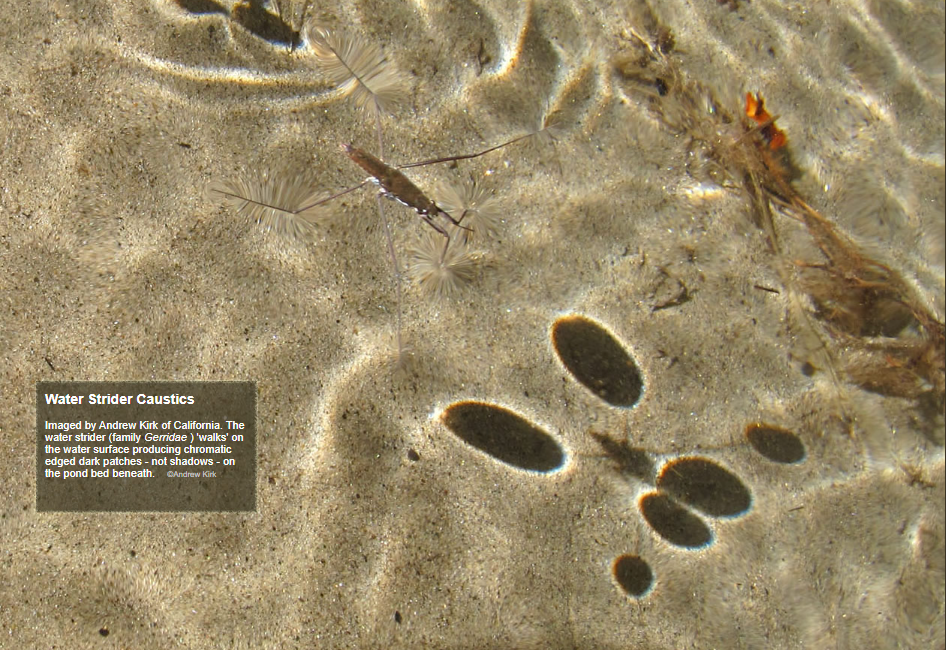OPOD - Strider Caustics
OPOD - Strider Caustics: Exploring the Phenomenon of Water Surface Reflections
Water striders, belonging to the family Gerridae, have a remarkable ability to walk on the surface of water. This intriguing behavior creates a mesmerizing visual spectacle known as water strider caustics. In this article, we will delve into the fascinating science behind these caustics and uncover the secrets of this captivating natural phenomenon.
When a water strider walks on the water's surface, it creates dark patches that are not shadows but rather chromatic-edged regions on the pond bed below. To understand why this occurs, we need to examine the unique properties of the water's surface.
The surface of water behaves like a tightly stretched elastic skin due to the cohesive forces between water molecules. Without this "skin," small creatures would not be able to walk on water. Instead of sinking, their legs depress the water's surface, creating a curved meniscus. The combination of surface tension forces generates an upward force that counteracts the weight of the insect, enabling it to stay afloat. It's akin to walking on a trampoline, with the surface of the water acting as the elastic material.
As the water's surface dips due to the presence of the insect, it causes light to refract and form a unique optical effect called a "caustic." The caustic is not a shadow but rather a region bounded by a bright caustic sheet. To visualize this, imagine a cross-section through the meniscus. As rays of light cross closer to the center of the meniscus, they become increasingly deflected. When these deflected rays intersect with each other lower down in the water, they cluster at the boundary between regions where pairs of rays cross and where no rays exist. This caustic surface appears intensely bright and crosses the pond bed, forming a luminous rim around the no-light zone.
The caustics produced by water striders exhibit vibrant colors, each corresponding to a slightly different caustic sheet. This color variation arises from the splitting of light into its spectral components as it emerges from the water. The interplay between the caustics and the refracted light adds to the visual allure of this phenomenon.
In addition to their remarkable ability to walk on water, water striders also engage in acrobatic movements. When they push with their back legs, they create symmetric waves on the water's surface. Interestingly, their front legs appear to be raised above the surface due to the absence of menisci. This behavior further enhances the visual spectacle created by these captivating creatures.
Water strider caustics offer a captivating glimpse into the intricacies of light and its interaction with the natural world. By understanding the science behind this phenomenon, we gain a deeper appreciation for the wonders that surround us. So, the next time you encounter water striders gracefully gliding across a pond, take a moment to marvel at the mesmerizing caustics they create and contemplate the beauty of nature's optical secrets.

Water Strider Caustics
Imaged by Andrew Kirk of California. The water strider (family Gerridae ) 'walks' on the water surface producing chromatic edged dark patches - not shadows - on the pond bed beneath. ©Andrew Kirk

A water surface acts as though it has a tightly stretched elastic skin. This results from the slight but cumulative attractive forces between water molecules . Without the ‘skin’ small creatures would no doubt have evolved in a way that did not involve them walking on water surfaces.
Small creatures are supported because their legs are not wetted. They do not penetrate the water surface. Instead they depress it into a curved meniscus. The surface tension forces combine to produce a net upthrust that counters the insect’s weight. With care and guile we can similarly support small metal objects on water. Imagine also walking across a trampoline.
The dipped surface refracts light to form a ‘no-light’ zone around the point where the tip of the insect’s leg would be shadowed. The no light zone is not a shadow. It instead marks a region bounded by a bright caustic sheet.
At left is a cross section through a meniscus. Rays crossing the meniscus closer and closer to its centre are increasingly deflected. Lower down in the water the deflected rays cross and cluster at the boundary between regions where pairs of rays cross and where there are no rays. This is a caustic surface and it is intensely bright. The surface crosses the pond bed to form a bright rim around the no-light zone.
Two processes colour the caustics. Each colour forms a slightly different caustic sheet. Light emerging from the water is further split into spectral colours.
Below: Strider Acrobatics - The creature pushes with its back legs producing strong symmetric waves. Its front legs appear to be raised above the surface because no menisci are present.

Note: this article has been automatically converted from the old site and may not appear as intended. You can find the original article here.
Reference Atmospheric Optics
If you use any of the definitions, information, or data presented on Atmospheric Optics, please copy the link or reference below to properly credit us as the reference source. Thank you!
-
<a href="https://atoptics.co.uk/blog/opod-strider-caustics/">OPOD - Strider Caustics</a>
-
"OPOD - Strider Caustics". Atmospheric Optics. Accessed on November 26, 2024. https://atoptics.co.uk/blog/opod-strider-caustics/.
-
"OPOD - Strider Caustics". Atmospheric Optics, https://atoptics.co.uk/blog/opod-strider-caustics/. Accessed 26 November, 2024
-
OPOD - Strider Caustics. Atmospheric Optics. Retrieved from https://atoptics.co.uk/blog/opod-strider-caustics/.